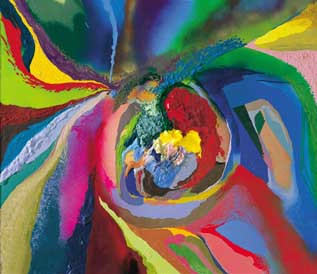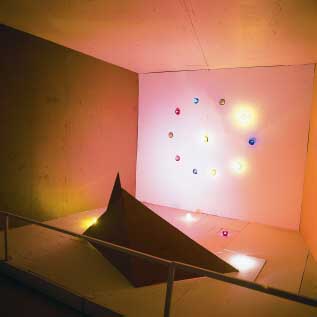
|
||
|
Portland art blog + news + exhibition reviews + galleries + contemporary northwest art
|
||
The Candor of Cali: Chris Johanson at The Portland Art Museum
Posted by Amy Bernstein on February 15, 2007 at 20:36 | Comments (13) Comments I found the "womb room" to be very northwesty... full of that northern lights meets jagged volcanic peak thing we take for granted here (heavenly ideals and earthy risks). It isn't executed in a precious manner though, which I really like. Johanson's work has always reminded me of southpark meets anime by way of lo-fi Dr. Who style special effects. In fact, I liked this installation a lot better than the one in Baja to Vancouver which I reviewed (positively) for Modern Painters several years ago. Also, the idea of what is "Portland art" has changed completely. It is multifaceted and no longer requires some reference to trees, stumps, craft, mysticism, shyness or hazy skies to be of this place. Examples: Sean Healy mocks and explores the "lizard brain" power dynamics of social groups. Chandra Bocci reimagines a world (through installation) that is both formally recontextualized and idealized while still being OF consumer culture. Jacqueline Ehlis is interested in the way materials change the experience of the viewer as a way to make life better. Daniel Peterson chronicles the tiny bohemian moments of freedom that make existence a little more magical. It's all about what makes life better. That is what Portland is about... it's the concsience of American cities and the artists are articulating it... Storm tharp, Jim Riswold, Matt McCormick, Bruce Conkle, Jesse Hayward, David Eckard, MK Guth, Brenden Clenaghen, Scott Wayne Indiana, Red 76 and Adam Sorenson are at it too. etc. the list is massive and I may write an essay. It's a kind of test kitchen for a better living (or a better meaning) and dont think the Film, Design and Music scenes are removed either. I think there is something very interesting going on here. It's a very mature sentiment, a more European but distinctly American sentiment. Posted by: Double J Thank god we have finally reached a point where it is very difficult to pinpoint exactly what "Portland art" is. Although, as we have discussed before, we have an affinity for 60s and 70s Formalism. I wonder why. Posted by: Calvin Ross Carl Few but the most out of touch are still scared of Greenberg. Instead the ideas that he promoted then suffocated have appeal again as a kind of idealism that cannot exist in our crappy social and political polarizations. It's Dave Hickey too... colors and texture are democratic. Matt Stadler's back room supper made this very obvious. Posted by: Double J What does it mean for an artist to be "influenced by street culture but not created by it"? Posted by: stephen_cleary I've been watching (and writing about) art in Portland for a decently long time now, and I think Jeff J. is kind of on to something with this idea of "conscience" as a unifying Portland ethos. The word potentially bundles up a lot of styles and practices in a way that seems relevant and roomy, and also seems to gesture toward 1960s liberal "conscience" in an interesting way. Less messianic, more practical here and now, though. One might argue that 60s liberalism, with all its attendant "conscience," and sloppiness, and pacifism, and art-making, has been living in hiding in the Willamette Valley since about 1979, and only lately has become strong enough again to assume its rightful place at the center of national discourse. That's one theory, anyway... Posted by: jon raymond Here's an article from the SFBG framing the 'Mission School' in a similar way. http://www.sfbg.com/36/28/art_mission_school.html Posted by: stephen_cleary Thanks Jon, There is a very strong humanistic impulse here that is getting increasingly ambitious, and demonstrative (it seems somewhat Swiss too). This humanistic conscience is precisely what draws people here or keeps them from wanting to be elsewhere. Not since the 1st half of the 20th century has it been more needed. Stephen, it's precisely those types of paradoxes that make successful artists what they are. Posted by: Double J Thanks for another great article on PORT, I like this site a lot. However, I have two corrections to make: first, ANP Quarterly is based in Los Angeles, not San Francisco as stated above. Also, it's not really a "grass roots" publication. You may not be aware that the three editors, especially Ed Templeton, are basically some of LA's biggest tastemakers in the indie art scene, and it's a slick, large-format magazine that doesn't need advertising to exist. On a related note, there's another Portlander (Bean Gilsdorf) in the latest issue. Posted by: jonesy Jeff, I didn't read it as a paradox. I don't understand what Amy is trying to say here. If the artists were not 'created' by the street, where were they 'created'? Posted by: stephen_cleary Stephen... I find that most artists react to a more general zeitgeist than "the street" and their philosophies seem to be aimed at things that arent just operating at the street level. The trick is to hit the other cultural targets. There is a reason Basquiat successfully moved beyond the samo tags. To get beyond the street but have credibility you have to be of and not of the street... an essential paradox for many artists, especially the mission school. Jonesey, thanks for the correction (people always ask about fact checking and blogs... and there you have it, we have a lot of informed readers who let us know when we arent right). Also, that description of ANP sounds like a very well connected grass roots effort. For me successful and influential indie music is still indie. Granted that is a very fine hair to split and I respect your call in seeing it the other way. It has a level of sophistication that screams big production. Posted by: Double J Jeff, Thank you for your thoughts. It is strange to discuss the meaning of Amy's words with you. McGee hit a lot of cultural targets with the work he did on "the streets" (a point Amy makes prior to the odd "influenced, but not created by" line). Since McGee still tags, he must not see graffiti as something he has to move "beyond". In interviews, he exalts the purity of the graffiti gesture. Posted by: stephen_cleary Meta chit chat isn't odd for me at all and most of the people I hang around with are constantly having funny meta conversations about other writers/artists and filmmakers... It's part of the atmosphere for me I guess. Maybe I could have used a different phrase but "moving beyond" the street doesnt have to be a final condition, simply something an artist can achieve. An artist can switch back and forth from the street and the privledged art environment seemlessly if they figure out how (like McGee). Still, it is necessary to own that paradox as McGee does if you want to be a big deal internationally while still keeping street cred. Talented guy and its why I feel paradox is of key concern here. credibility is a huge issue too Posted by: Double J I wonder if paradox is too strong of a word now? It's interesting to look back at the early 'Mission School' interviews and reviews, when there was a lot of emphasis put on 'street cred', and institutional success was a cause for concern. Does anyone even need 'street cred' now? It has become commonplace to see artists exhibit at different venues to vastly different audiences. Think about Johanson at Reading Frenzy, Vanessa Renwick's tours, or Bill Daniel showing The Girl On The Train In The Moon in front of a Motherwell one day, and under a bridge the next. I agree that credibility is an important issue, but It has shifted from the narrow frame of 'street' vs. 'institution' to artists staying true to their own sensibilities. It's easy to forget that these artists were using the same approach when it wasn't exactly considered a wise career move. I may have misread the 'influenced, but not created' line to mean that the artists had developed a sophisticated language, and therefore could only be influenced by the street-not created by it. I'm of the opinion that these artists are a product of 'the streets' as much as anything/where else, but what that means (or maybe the importance of that distinction), has changed considerably in the last ten years. Who knows? Maybe one day, institutions (like UCLA Hammer) won't feel required to tell us that Chris Johanson "has taken classes in history, sociology, and philosophy at various Northern California institutions". Posted by: stephen_cleary Post a comment Thanks for signing in, . Now you can comment. (sign out)
(If you haven't left a comment here before, you may need to be approved by
the site owner before your comment will appear. Until then, it won't appear
on the entry. Thanks for waiting.)
|
| s p o n s o r s |
 |
 |
 |
 |
 |
 |
 |
 |
 |
 |
 |
 |
 |
 |
 |
 |

|
Site Design: Jennifer Armbrust | • | Site Development: Philippe Blanc & Katherine Bovee | |




![[TypeKey Profile Page]](http://www.portlandart.net/nav-commenters.gif)